Human Resource Management Report: Vodafone HRM Analysis and Practices
VerifiedAdded on 2021/01/02
|14
|4059
|252
Report
AI Summary
This report provides a comprehensive analysis of Human Resource Management (HRM) practices within Vodafone, a multinational telecommunications company. The report begins with an introduction to HRM, defining its purpose and functions, particularly focusing on workforce planning and resourcing. It delves into the strengths and weaknesses of internal and external recruitment and selection processes, evaluating their effectiveness. The report then explores the advantages of HRM for both employees and employers, highlighting its role in fostering a productive work environment and improving organizational profitability. Key HRM practices, such as performance management, employee development, and training, are examined in detail. Furthermore, the report analyzes the influence of employee-related factors on HRM decision-making and the impact of employment legislation. The report concludes with an overview of HRM practices in the context of the workplace, summarizing the key findings and implications for Vodafone's HRM strategies.
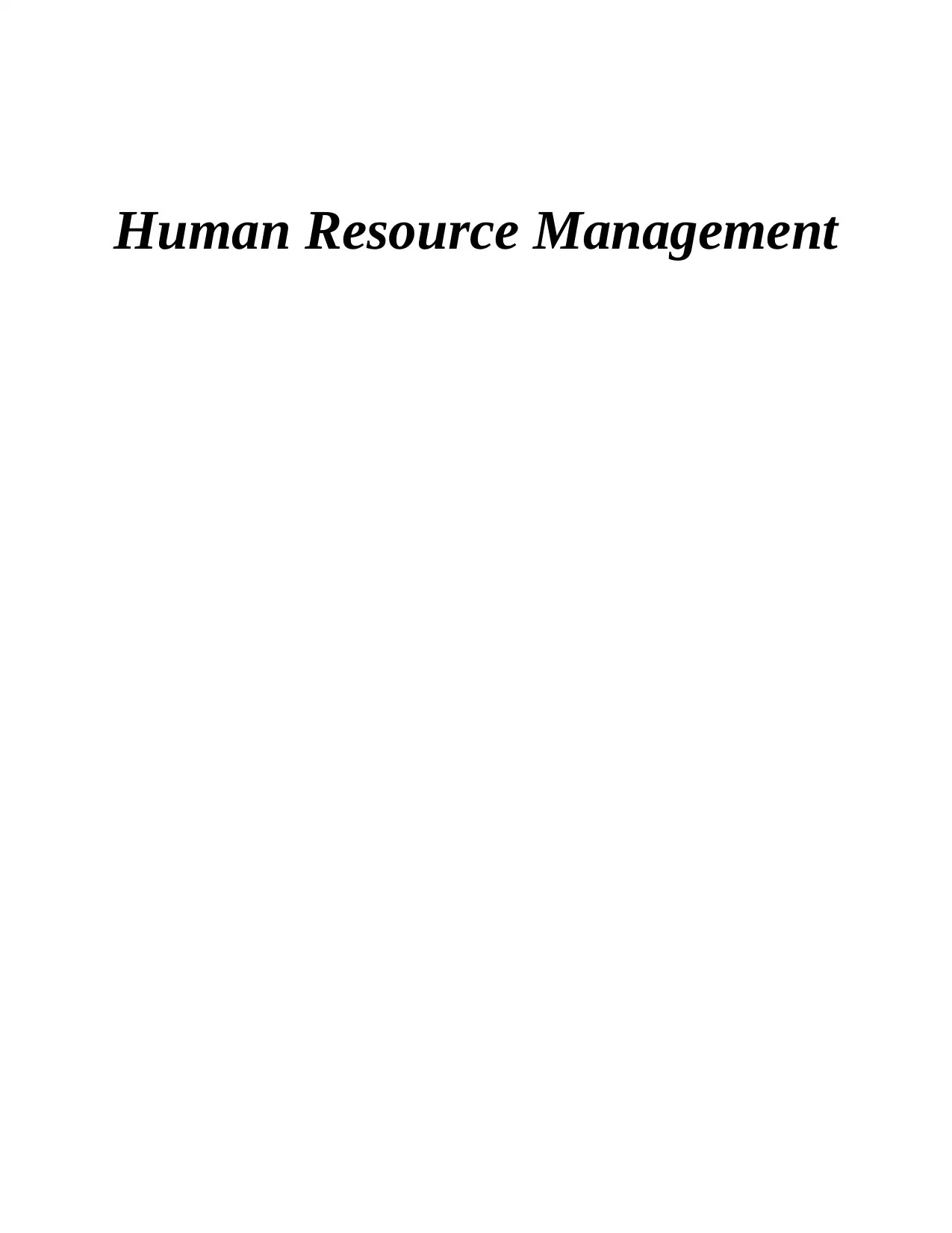
Human Resource Management
Paraphrase This Document
Need a fresh take? Get an instant paraphrase of this document with our AI Paraphraser
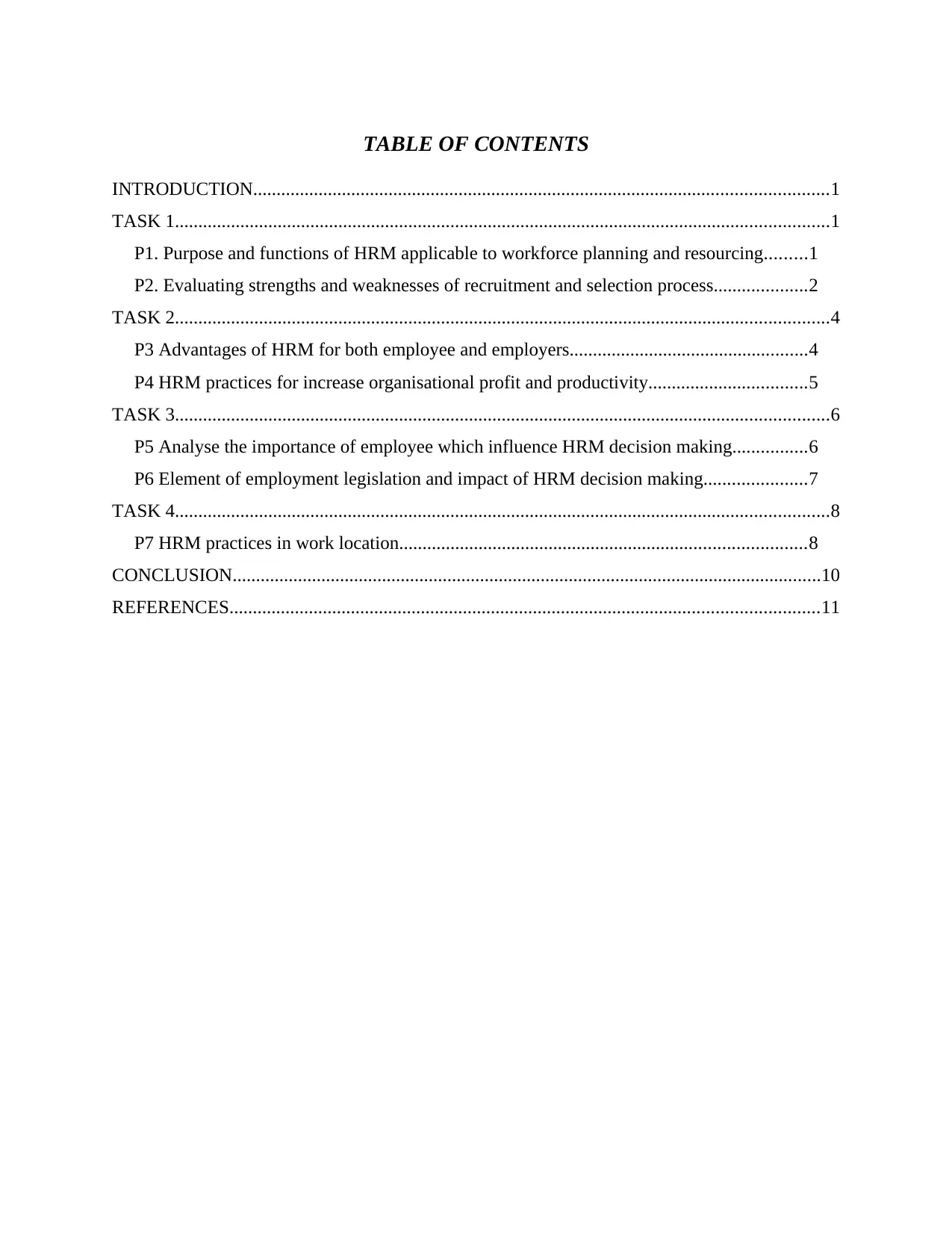
TABLE OF CONTENTS
INTRODUCTION...........................................................................................................................1
TASK 1............................................................................................................................................1
P1. Purpose and functions of HRM applicable to workforce planning and resourcing.........1
P2. Evaluating strengths and weaknesses of recruitment and selection process....................2
TASK 2............................................................................................................................................4
P3 Advantages of HRM for both employee and employers...................................................4
P4 HRM practices for increase organisational profit and productivity..................................5
TASK 3............................................................................................................................................6
P5 Analyse the importance of employee which influence HRM decision making................6
P6 Element of employment legislation and impact of HRM decision making......................7
TASK 4............................................................................................................................................8
P7 HRM practices in work location.......................................................................................8
CONCLUSION..............................................................................................................................10
REFERENCES..............................................................................................................................11
INTRODUCTION...........................................................................................................................1
TASK 1............................................................................................................................................1
P1. Purpose and functions of HRM applicable to workforce planning and resourcing.........1
P2. Evaluating strengths and weaknesses of recruitment and selection process....................2
TASK 2............................................................................................................................................4
P3 Advantages of HRM for both employee and employers...................................................4
P4 HRM practices for increase organisational profit and productivity..................................5
TASK 3............................................................................................................................................6
P5 Analyse the importance of employee which influence HRM decision making................6
P6 Element of employment legislation and impact of HRM decision making......................7
TASK 4............................................................................................................................................8
P7 HRM practices in work location.......................................................................................8
CONCLUSION..............................................................................................................................10
REFERENCES..............................................................................................................................11
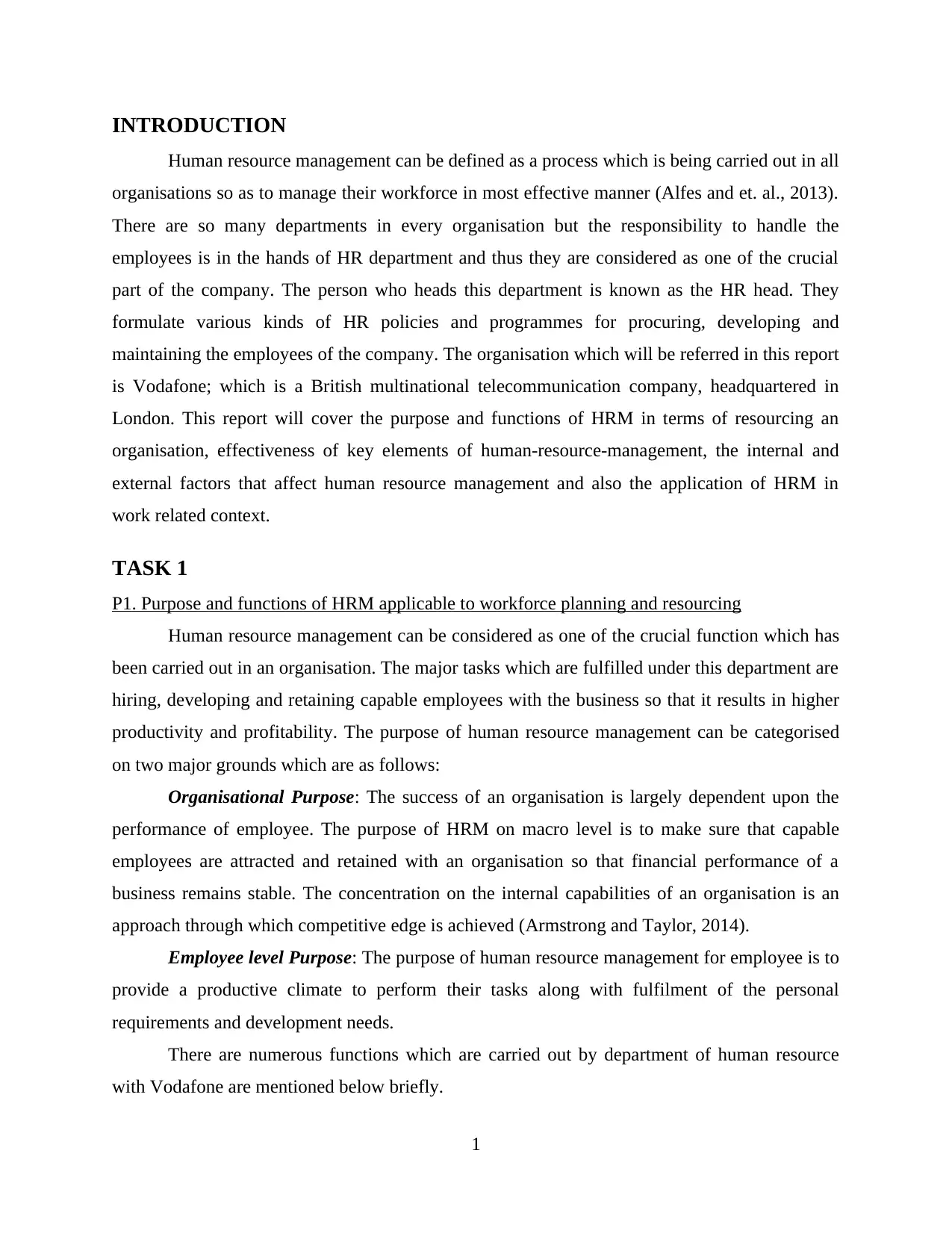
INTRODUCTION
Human resource management can be defined as a process which is being carried out in all
organisations so as to manage their workforce in most effective manner (Alfes and et. al., 2013).
There are so many departments in every organisation but the responsibility to handle the
employees is in the hands of HR department and thus they are considered as one of the crucial
part of the company. The person who heads this department is known as the HR head. They
formulate various kinds of HR policies and programmes for procuring, developing and
maintaining the employees of the company. The organisation which will be referred in this report
is Vodafone; which is a British multinational telecommunication company, headquartered in
London. This report will cover the purpose and functions of HRM in terms of resourcing an
organisation, effectiveness of key elements of human-resource-management, the internal and
external factors that affect human resource management and also the application of HRM in
work related context.
TASK 1
P1. Purpose and functions of HRM applicable to workforce planning and resourcing
Human resource management can be considered as one of the crucial function which has
been carried out in an organisation. The major tasks which are fulfilled under this department are
hiring, developing and retaining capable employees with the business so that it results in higher
productivity and profitability. The purpose of human resource management can be categorised
on two major grounds which are as follows:
Organisational Purpose: The success of an organisation is largely dependent upon the
performance of employee. The purpose of HRM on macro level is to make sure that capable
employees are attracted and retained with an organisation so that financial performance of a
business remains stable. The concentration on the internal capabilities of an organisation is an
approach through which competitive edge is achieved (Armstrong and Taylor, 2014).
Employee level Purpose: The purpose of human resource management for employee is to
provide a productive climate to perform their tasks along with fulfilment of the personal
requirements and development needs.
There are numerous functions which are carried out by department of human resource
with Vodafone are mentioned below briefly.
1
Human resource management can be defined as a process which is being carried out in all
organisations so as to manage their workforce in most effective manner (Alfes and et. al., 2013).
There are so many departments in every organisation but the responsibility to handle the
employees is in the hands of HR department and thus they are considered as one of the crucial
part of the company. The person who heads this department is known as the HR head. They
formulate various kinds of HR policies and programmes for procuring, developing and
maintaining the employees of the company. The organisation which will be referred in this report
is Vodafone; which is a British multinational telecommunication company, headquartered in
London. This report will cover the purpose and functions of HRM in terms of resourcing an
organisation, effectiveness of key elements of human-resource-management, the internal and
external factors that affect human resource management and also the application of HRM in
work related context.
TASK 1
P1. Purpose and functions of HRM applicable to workforce planning and resourcing
Human resource management can be considered as one of the crucial function which has
been carried out in an organisation. The major tasks which are fulfilled under this department are
hiring, developing and retaining capable employees with the business so that it results in higher
productivity and profitability. The purpose of human resource management can be categorised
on two major grounds which are as follows:
Organisational Purpose: The success of an organisation is largely dependent upon the
performance of employee. The purpose of HRM on macro level is to make sure that capable
employees are attracted and retained with an organisation so that financial performance of a
business remains stable. The concentration on the internal capabilities of an organisation is an
approach through which competitive edge is achieved (Armstrong and Taylor, 2014).
Employee level Purpose: The purpose of human resource management for employee is to
provide a productive climate to perform their tasks along with fulfilment of the personal
requirements and development needs.
There are numerous functions which are carried out by department of human resource
with Vodafone are mentioned below briefly.
1
⊘ This is a preview!⊘
Do you want full access?
Subscribe today to unlock all pages.

Trusted by 1+ million students worldwide
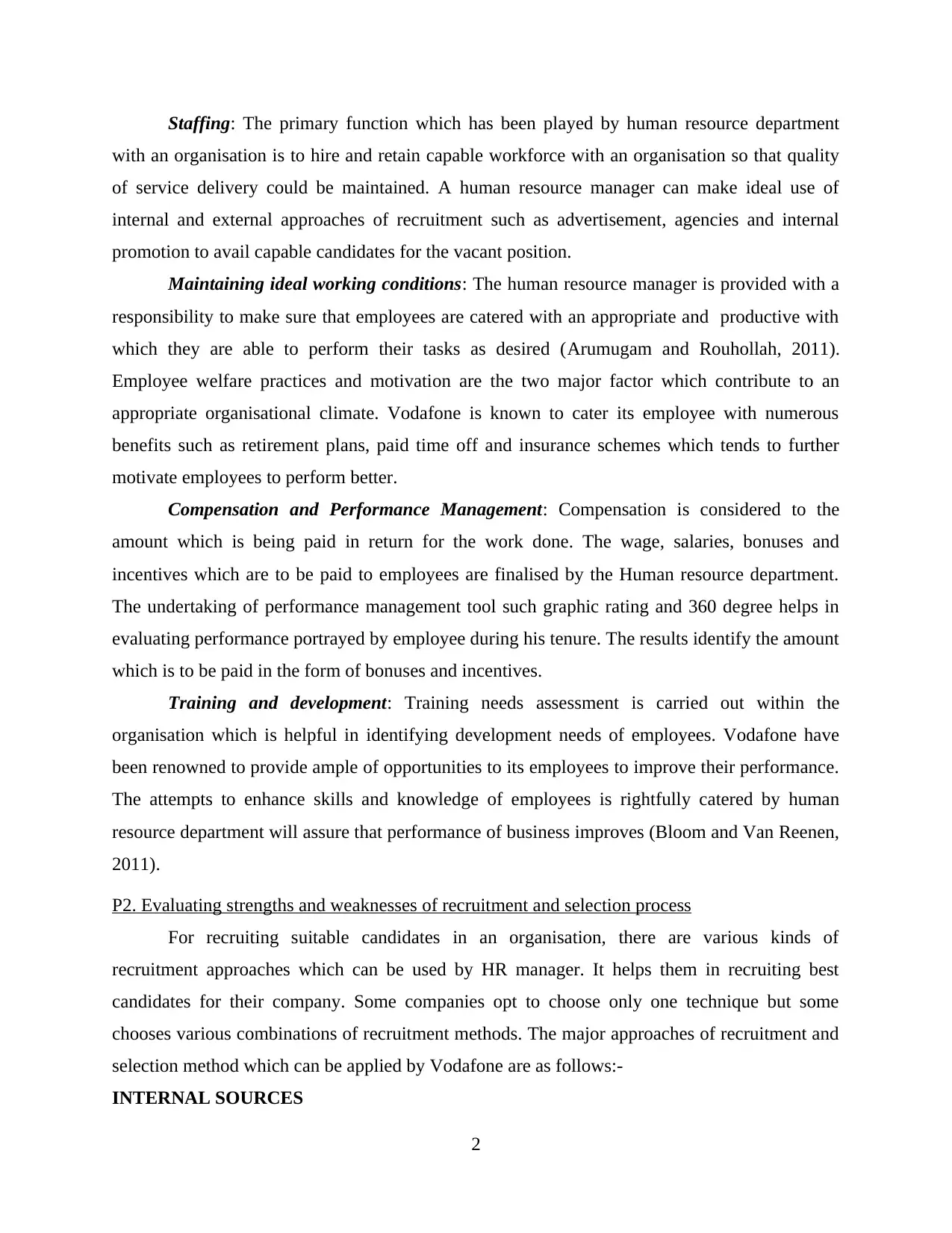
Staffing: The primary function which has been played by human resource department
with an organisation is to hire and retain capable workforce with an organisation so that quality
of service delivery could be maintained. A human resource manager can make ideal use of
internal and external approaches of recruitment such as advertisement, agencies and internal
promotion to avail capable candidates for the vacant position.
Maintaining ideal working conditions: The human resource manager is provided with a
responsibility to make sure that employees are catered with an appropriate and productive with
which they are able to perform their tasks as desired (Arumugam and Rouhollah, 2011).
Employee welfare practices and motivation are the two major factor which contribute to an
appropriate organisational climate. Vodafone is known to cater its employee with numerous
benefits such as retirement plans, paid time off and insurance schemes which tends to further
motivate employees to perform better.
Compensation and Performance Management: Compensation is considered to the
amount which is being paid in return for the work done. The wage, salaries, bonuses and
incentives which are to be paid to employees are finalised by the Human resource department.
The undertaking of performance management tool such graphic rating and 360 degree helps in
evaluating performance portrayed by employee during his tenure. The results identify the amount
which is to be paid in the form of bonuses and incentives.
Training and development: Training needs assessment is carried out within the
organisation which is helpful in identifying development needs of employees. Vodafone have
been renowned to provide ample of opportunities to its employees to improve their performance.
The attempts to enhance skills and knowledge of employees is rightfully catered by human
resource department will assure that performance of business improves (Bloom and Van Reenen,
2011).
P2. Evaluating strengths and weaknesses of recruitment and selection process
For recruiting suitable candidates in an organisation, there are various kinds of
recruitment approaches which can be used by HR manager. It helps them in recruiting best
candidates for their company. Some companies opt to choose only one technique but some
chooses various combinations of recruitment methods. The major approaches of recruitment and
selection method which can be applied by Vodafone are as follows:-
INTERNAL SOURCES
2
with an organisation is to hire and retain capable workforce with an organisation so that quality
of service delivery could be maintained. A human resource manager can make ideal use of
internal and external approaches of recruitment such as advertisement, agencies and internal
promotion to avail capable candidates for the vacant position.
Maintaining ideal working conditions: The human resource manager is provided with a
responsibility to make sure that employees are catered with an appropriate and productive with
which they are able to perform their tasks as desired (Arumugam and Rouhollah, 2011).
Employee welfare practices and motivation are the two major factor which contribute to an
appropriate organisational climate. Vodafone is known to cater its employee with numerous
benefits such as retirement plans, paid time off and insurance schemes which tends to further
motivate employees to perform better.
Compensation and Performance Management: Compensation is considered to the
amount which is being paid in return for the work done. The wage, salaries, bonuses and
incentives which are to be paid to employees are finalised by the Human resource department.
The undertaking of performance management tool such graphic rating and 360 degree helps in
evaluating performance portrayed by employee during his tenure. The results identify the amount
which is to be paid in the form of bonuses and incentives.
Training and development: Training needs assessment is carried out within the
organisation which is helpful in identifying development needs of employees. Vodafone have
been renowned to provide ample of opportunities to its employees to improve their performance.
The attempts to enhance skills and knowledge of employees is rightfully catered by human
resource department will assure that performance of business improves (Bloom and Van Reenen,
2011).
P2. Evaluating strengths and weaknesses of recruitment and selection process
For recruiting suitable candidates in an organisation, there are various kinds of
recruitment approaches which can be used by HR manager. It helps them in recruiting best
candidates for their company. Some companies opt to choose only one technique but some
chooses various combinations of recruitment methods. The major approaches of recruitment and
selection method which can be applied by Vodafone are as follows:-
INTERNAL SOURCES
2
Paraphrase This Document
Need a fresh take? Get an instant paraphrase of this document with our AI Paraphraser
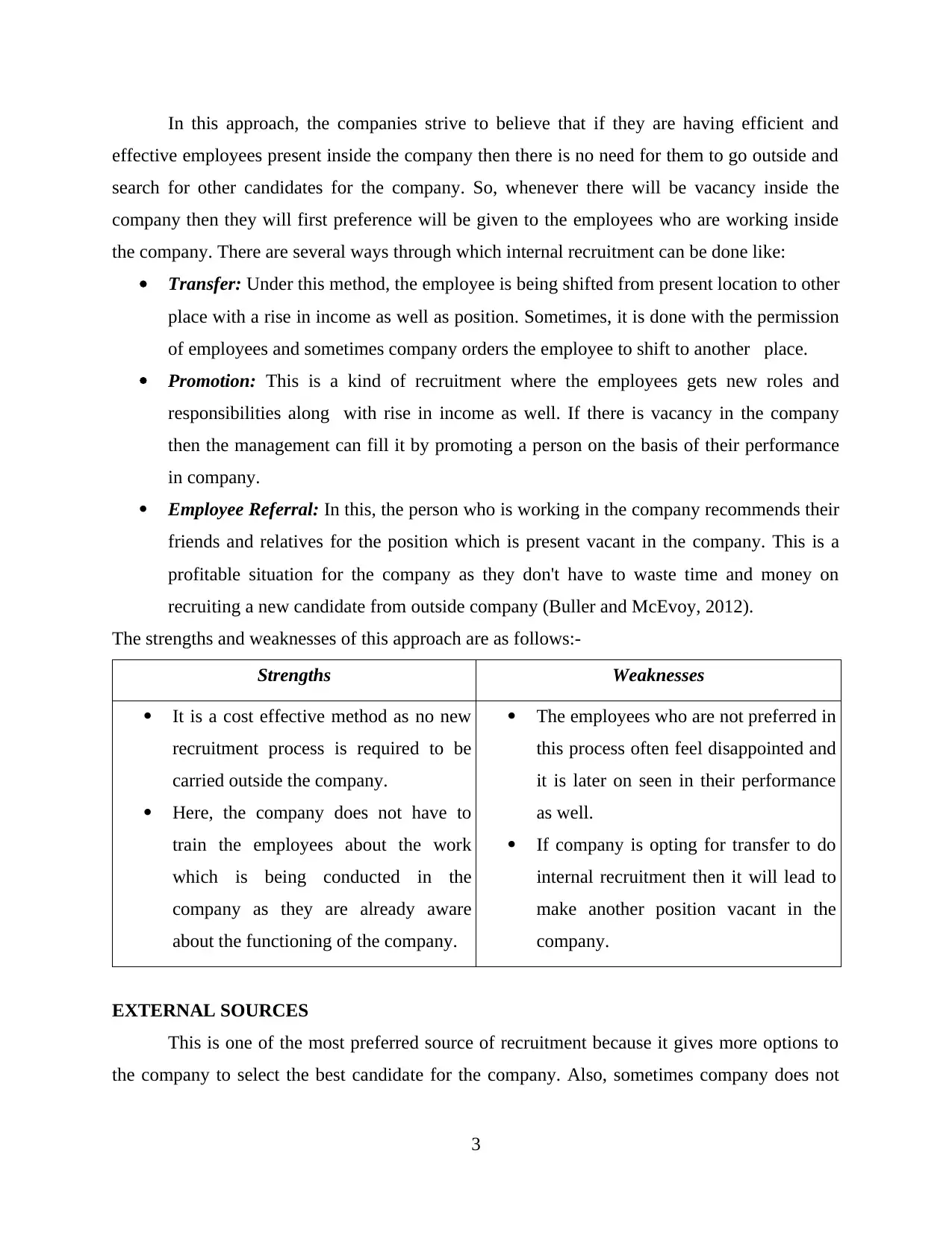
In this approach, the companies strive to believe that if they are having efficient and
effective employees present inside the company then there is no need for them to go outside and
search for other candidates for the company. So, whenever there will be vacancy inside the
company then they will first preference will be given to the employees who are working inside
the company. There are several ways through which internal recruitment can be done like:
Transfer: Under this method, the employee is being shifted from present location to other
place with a rise in income as well as position. Sometimes, it is done with the permission
of employees and sometimes company orders the employee to shift to another place.
Promotion: This is a kind of recruitment where the employees gets new roles and
responsibilities along with rise in income as well. If there is vacancy in the company
then the management can fill it by promoting a person on the basis of their performance
in company.
Employee Referral: In this, the person who is working in the company recommends their
friends and relatives for the position which is present vacant in the company. This is a
profitable situation for the company as they don't have to waste time and money on
recruiting a new candidate from outside company (Buller and McEvoy, 2012).
The strengths and weaknesses of this approach are as follows:-
Strengths Weaknesses
It is a cost effective method as no new
recruitment process is required to be
carried outside the company.
Here, the company does not have to
train the employees about the work
which is being conducted in the
company as they are already aware
about the functioning of the company.
The employees who are not preferred in
this process often feel disappointed and
it is later on seen in their performance
as well.
If company is opting for transfer to do
internal recruitment then it will lead to
make another position vacant in the
company.
EXTERNAL SOURCES
This is one of the most preferred source of recruitment because it gives more options to
the company to select the best candidate for the company. Also, sometimes company does not
3
effective employees present inside the company then there is no need for them to go outside and
search for other candidates for the company. So, whenever there will be vacancy inside the
company then they will first preference will be given to the employees who are working inside
the company. There are several ways through which internal recruitment can be done like:
Transfer: Under this method, the employee is being shifted from present location to other
place with a rise in income as well as position. Sometimes, it is done with the permission
of employees and sometimes company orders the employee to shift to another place.
Promotion: This is a kind of recruitment where the employees gets new roles and
responsibilities along with rise in income as well. If there is vacancy in the company
then the management can fill it by promoting a person on the basis of their performance
in company.
Employee Referral: In this, the person who is working in the company recommends their
friends and relatives for the position which is present vacant in the company. This is a
profitable situation for the company as they don't have to waste time and money on
recruiting a new candidate from outside company (Buller and McEvoy, 2012).
The strengths and weaknesses of this approach are as follows:-
Strengths Weaknesses
It is a cost effective method as no new
recruitment process is required to be
carried outside the company.
Here, the company does not have to
train the employees about the work
which is being conducted in the
company as they are already aware
about the functioning of the company.
The employees who are not preferred in
this process often feel disappointed and
it is later on seen in their performance
as well.
If company is opting for transfer to do
internal recruitment then it will lead to
make another position vacant in the
company.
EXTERNAL SOURCES
This is one of the most preferred source of recruitment because it gives more options to
the company to select the best candidate for the company. Also, sometimes company does not
3
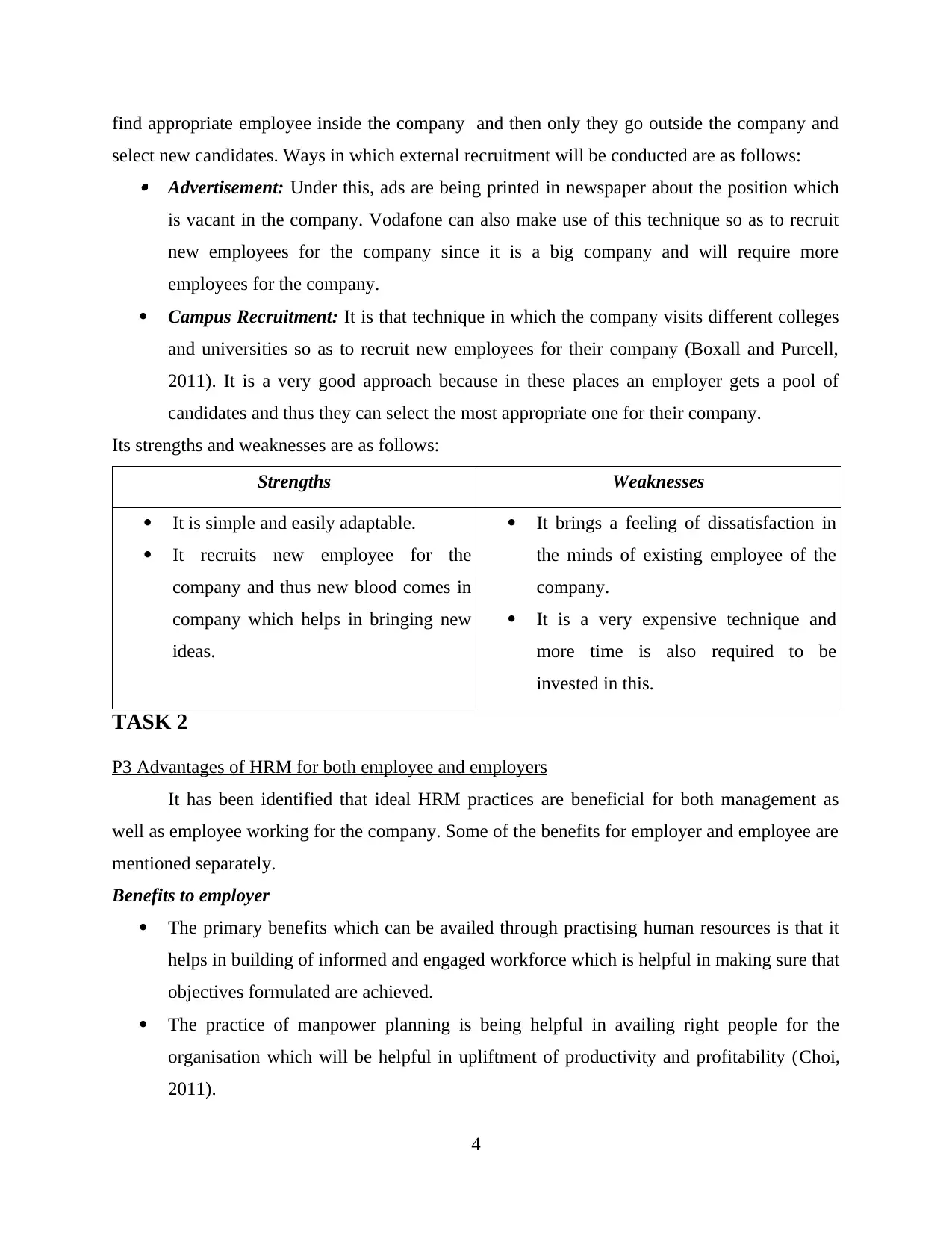
find appropriate employee inside the company and then only they go outside the company and
select new candidates. Ways in which external recruitment will be conducted are as follows: Advertisement: Under this, ads are being printed in newspaper about the position which
is vacant in the company. Vodafone can also make use of this technique so as to recruit
new employees for the company since it is a big company and will require more
employees for the company.
Campus Recruitment: It is that technique in which the company visits different colleges
and universities so as to recruit new employees for their company (Boxall and Purcell,
2011). It is a very good approach because in these places an employer gets a pool of
candidates and thus they can select the most appropriate one for their company.
Its strengths and weaknesses are as follows:
Strengths Weaknesses
It is simple and easily adaptable.
It recruits new employee for the
company and thus new blood comes in
company which helps in bringing new
ideas.
It brings a feeling of dissatisfaction in
the minds of existing employee of the
company.
It is a very expensive technique and
more time is also required to be
invested in this.
TASK 2
P3 Advantages of HRM for both employee and employers
It has been identified that ideal HRM practices are beneficial for both management as
well as employee working for the company. Some of the benefits for employer and employee are
mentioned separately.
Benefits to employer
The primary benefits which can be availed through practising human resources is that it
helps in building of informed and engaged workforce which is helpful in making sure that
objectives formulated are achieved.
The practice of manpower planning is being helpful in availing right people for the
organisation which will be helpful in upliftment of productivity and profitability (Choi,
2011).
4
select new candidates. Ways in which external recruitment will be conducted are as follows: Advertisement: Under this, ads are being printed in newspaper about the position which
is vacant in the company. Vodafone can also make use of this technique so as to recruit
new employees for the company since it is a big company and will require more
employees for the company.
Campus Recruitment: It is that technique in which the company visits different colleges
and universities so as to recruit new employees for their company (Boxall and Purcell,
2011). It is a very good approach because in these places an employer gets a pool of
candidates and thus they can select the most appropriate one for their company.
Its strengths and weaknesses are as follows:
Strengths Weaknesses
It is simple and easily adaptable.
It recruits new employee for the
company and thus new blood comes in
company which helps in bringing new
ideas.
It brings a feeling of dissatisfaction in
the minds of existing employee of the
company.
It is a very expensive technique and
more time is also required to be
invested in this.
TASK 2
P3 Advantages of HRM for both employee and employers
It has been identified that ideal HRM practices are beneficial for both management as
well as employee working for the company. Some of the benefits for employer and employee are
mentioned separately.
Benefits to employer
The primary benefits which can be availed through practising human resources is that it
helps in building of informed and engaged workforce which is helpful in making sure that
objectives formulated are achieved.
The practice of manpower planning is being helpful in availing right people for the
organisation which will be helpful in upliftment of productivity and profitability (Choi,
2011).
4
⊘ This is a preview!⊘
Do you want full access?
Subscribe today to unlock all pages.

Trusted by 1+ million students worldwide
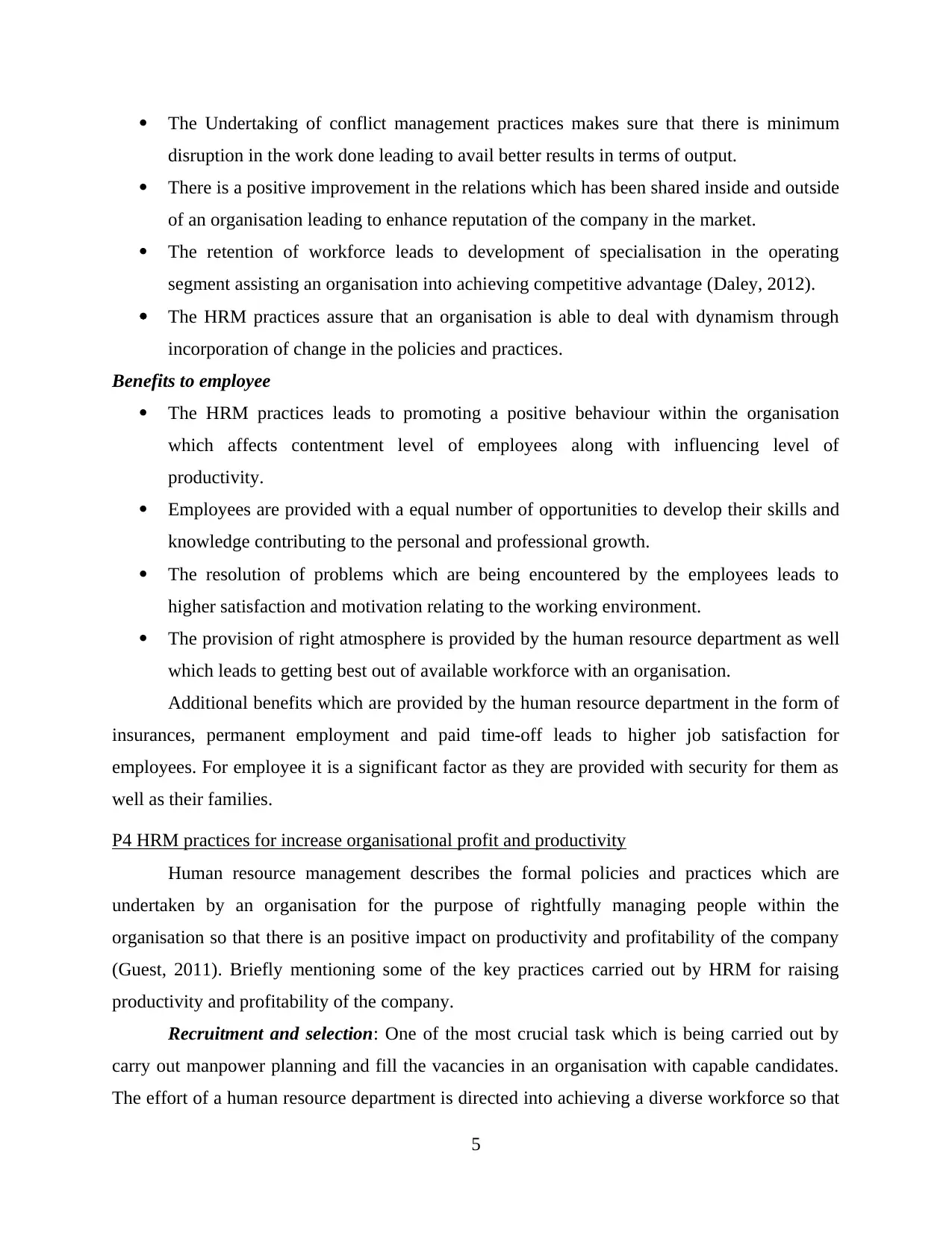
The Undertaking of conflict management practices makes sure that there is minimum
disruption in the work done leading to avail better results in terms of output.
There is a positive improvement in the relations which has been shared inside and outside
of an organisation leading to enhance reputation of the company in the market.
The retention of workforce leads to development of specialisation in the operating
segment assisting an organisation into achieving competitive advantage (Daley, 2012).
The HRM practices assure that an organisation is able to deal with dynamism through
incorporation of change in the policies and practices.
Benefits to employee
The HRM practices leads to promoting a positive behaviour within the organisation
which affects contentment level of employees along with influencing level of
productivity.
Employees are provided with a equal number of opportunities to develop their skills and
knowledge contributing to the personal and professional growth.
The resolution of problems which are being encountered by the employees leads to
higher satisfaction and motivation relating to the working environment.
The provision of right atmosphere is provided by the human resource department as well
which leads to getting best out of available workforce with an organisation.
Additional benefits which are provided by the human resource department in the form of
insurances, permanent employment and paid time-off leads to higher job satisfaction for
employees. For employee it is a significant factor as they are provided with security for them as
well as their families.
P4 HRM practices for increase organisational profit and productivity
Human resource management describes the formal policies and practices which are
undertaken by an organisation for the purpose of rightfully managing people within the
organisation so that there is an positive impact on productivity and profitability of the company
(Guest, 2011). Briefly mentioning some of the key practices carried out by HRM for raising
productivity and profitability of the company.
Recruitment and selection: One of the most crucial task which is being carried out by
carry out manpower planning and fill the vacancies in an organisation with capable candidates.
The effort of a human resource department is directed into achieving a diverse workforce so that
5
disruption in the work done leading to avail better results in terms of output.
There is a positive improvement in the relations which has been shared inside and outside
of an organisation leading to enhance reputation of the company in the market.
The retention of workforce leads to development of specialisation in the operating
segment assisting an organisation into achieving competitive advantage (Daley, 2012).
The HRM practices assure that an organisation is able to deal with dynamism through
incorporation of change in the policies and practices.
Benefits to employee
The HRM practices leads to promoting a positive behaviour within the organisation
which affects contentment level of employees along with influencing level of
productivity.
Employees are provided with a equal number of opportunities to develop their skills and
knowledge contributing to the personal and professional growth.
The resolution of problems which are being encountered by the employees leads to
higher satisfaction and motivation relating to the working environment.
The provision of right atmosphere is provided by the human resource department as well
which leads to getting best out of available workforce with an organisation.
Additional benefits which are provided by the human resource department in the form of
insurances, permanent employment and paid time-off leads to higher job satisfaction for
employees. For employee it is a significant factor as they are provided with security for them as
well as their families.
P4 HRM practices for increase organisational profit and productivity
Human resource management describes the formal policies and practices which are
undertaken by an organisation for the purpose of rightfully managing people within the
organisation so that there is an positive impact on productivity and profitability of the company
(Guest, 2011). Briefly mentioning some of the key practices carried out by HRM for raising
productivity and profitability of the company.
Recruitment and selection: One of the most crucial task which is being carried out by
carry out manpower planning and fill the vacancies in an organisation with capable candidates.
The effort of a human resource department is directed into achieving a diverse workforce so that
5
Paraphrase This Document
Need a fresh take? Get an instant paraphrase of this document with our AI Paraphraser
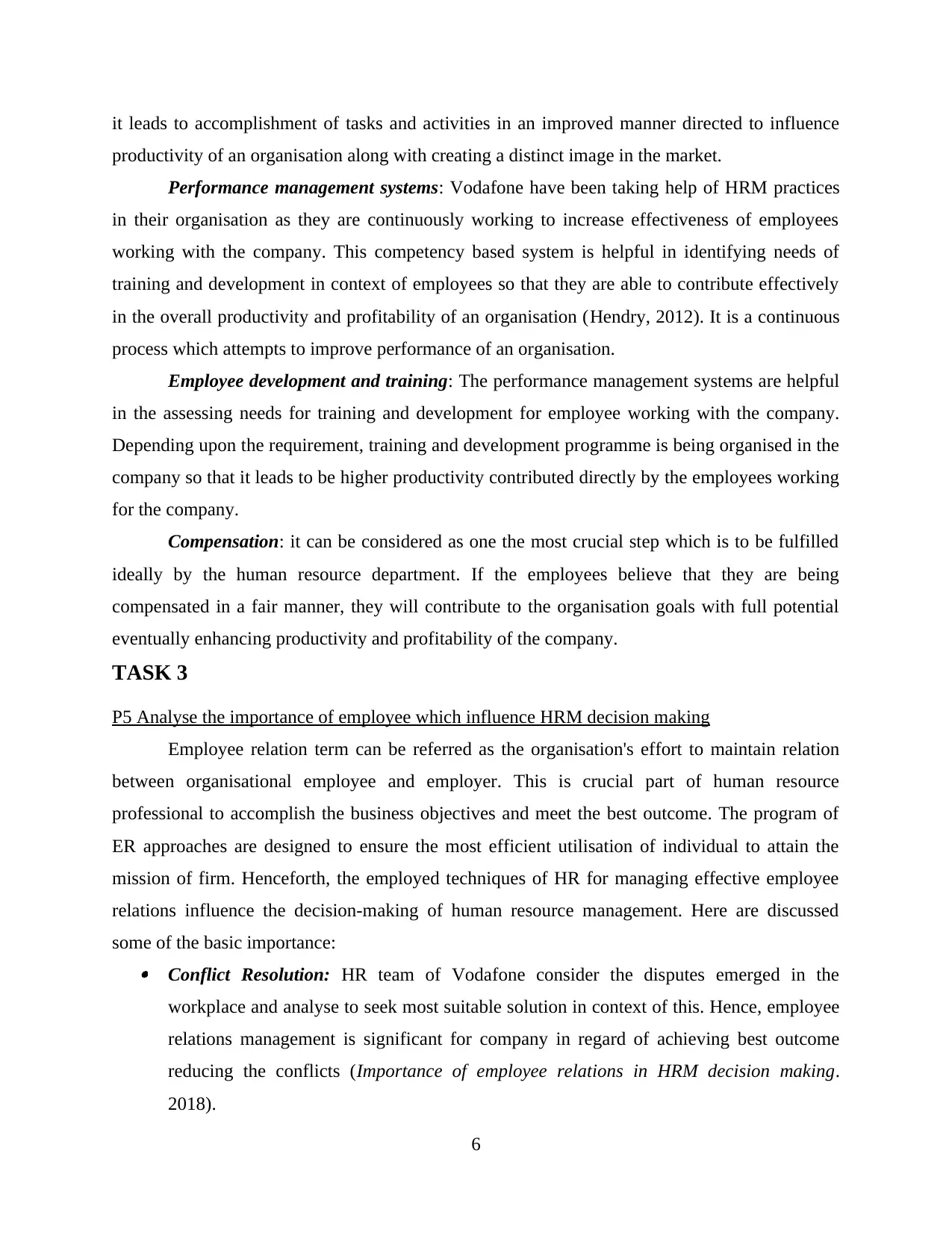
it leads to accomplishment of tasks and activities in an improved manner directed to influence
productivity of an organisation along with creating a distinct image in the market.
Performance management systems: Vodafone have been taking help of HRM practices
in their organisation as they are continuously working to increase effectiveness of employees
working with the company. This competency based system is helpful in identifying needs of
training and development in context of employees so that they are able to contribute effectively
in the overall productivity and profitability of an organisation (Hendry, 2012). It is a continuous
process which attempts to improve performance of an organisation.
Employee development and training: The performance management systems are helpful
in the assessing needs for training and development for employee working with the company.
Depending upon the requirement, training and development programme is being organised in the
company so that it leads to be higher productivity contributed directly by the employees working
for the company.
Compensation: it can be considered as one the most crucial step which is to be fulfilled
ideally by the human resource department. If the employees believe that they are being
compensated in a fair manner, they will contribute to the organisation goals with full potential
eventually enhancing productivity and profitability of the company.
TASK 3
P5 Analyse the importance of employee which influence HRM decision making
Employee relation term can be referred as the organisation's effort to maintain relation
between organisational employee and employer. This is crucial part of human resource
professional to accomplish the business objectives and meet the best outcome. The program of
ER approaches are designed to ensure the most efficient utilisation of individual to attain the
mission of firm. Henceforth, the employed techniques of HR for managing effective employee
relations influence the decision-making of human resource management. Here are discussed
some of the basic importance: Conflict Resolution: HR team of Vodafone consider the disputes emerged in the
workplace and analyse to seek most suitable solution in context of this. Hence, employee
relations management is significant for company in regard of achieving best outcome
reducing the conflicts (Importance of employee relations in HRM decision making.
2018).
6
productivity of an organisation along with creating a distinct image in the market.
Performance management systems: Vodafone have been taking help of HRM practices
in their organisation as they are continuously working to increase effectiveness of employees
working with the company. This competency based system is helpful in identifying needs of
training and development in context of employees so that they are able to contribute effectively
in the overall productivity and profitability of an organisation (Hendry, 2012). It is a continuous
process which attempts to improve performance of an organisation.
Employee development and training: The performance management systems are helpful
in the assessing needs for training and development for employee working with the company.
Depending upon the requirement, training and development programme is being organised in the
company so that it leads to be higher productivity contributed directly by the employees working
for the company.
Compensation: it can be considered as one the most crucial step which is to be fulfilled
ideally by the human resource department. If the employees believe that they are being
compensated in a fair manner, they will contribute to the organisation goals with full potential
eventually enhancing productivity and profitability of the company.
TASK 3
P5 Analyse the importance of employee which influence HRM decision making
Employee relation term can be referred as the organisation's effort to maintain relation
between organisational employee and employer. This is crucial part of human resource
professional to accomplish the business objectives and meet the best outcome. The program of
ER approaches are designed to ensure the most efficient utilisation of individual to attain the
mission of firm. Henceforth, the employed techniques of HR for managing effective employee
relations influence the decision-making of human resource management. Here are discussed
some of the basic importance: Conflict Resolution: HR team of Vodafone consider the disputes emerged in the
workplace and analyse to seek most suitable solution in context of this. Hence, employee
relations management is significant for company in regard of achieving best outcome
reducing the conflicts (Importance of employee relations in HRM decision making.
2018).
6
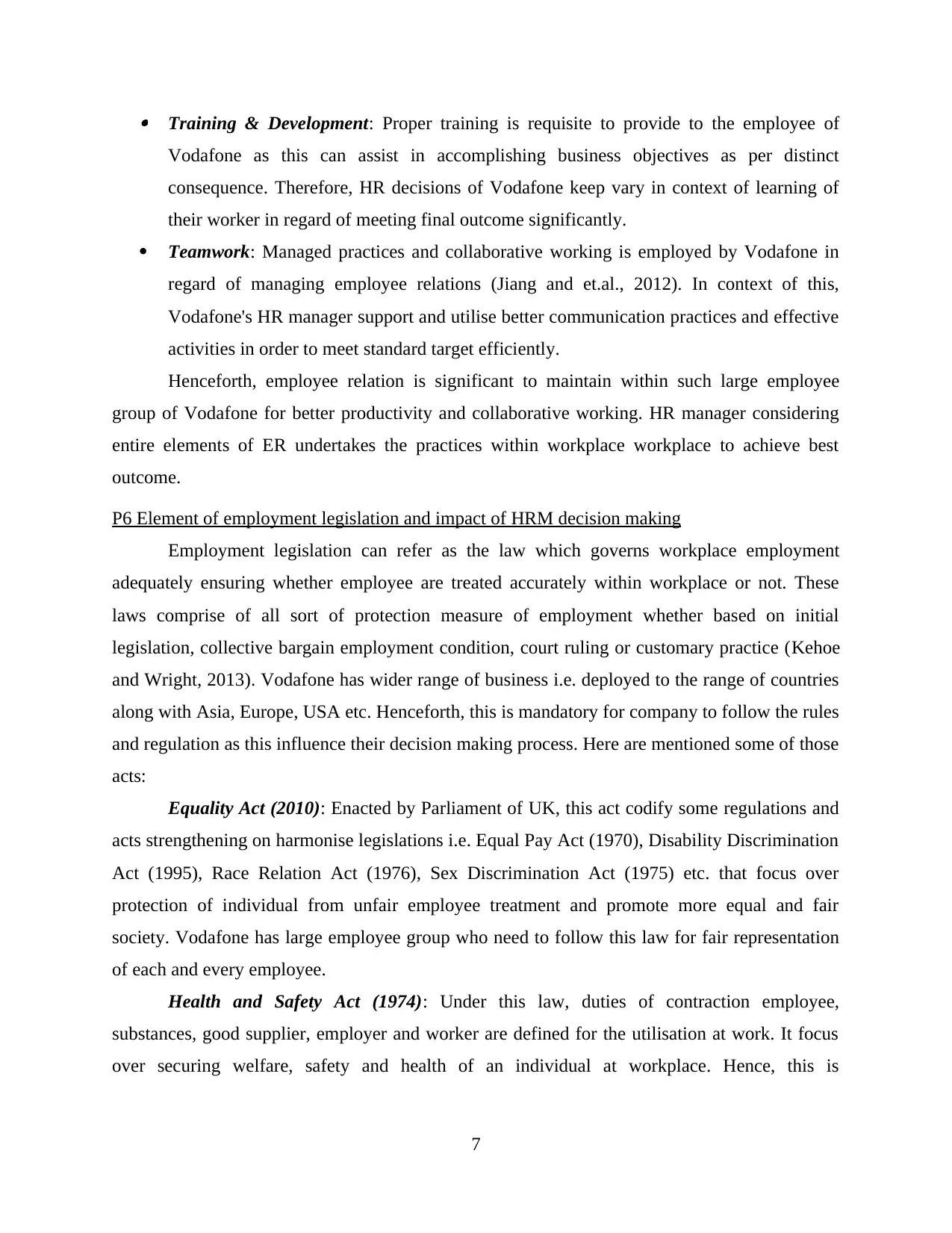
Training & Development: Proper training is requisite to provide to the employee of
Vodafone as this can assist in accomplishing business objectives as per distinct
consequence. Therefore, HR decisions of Vodafone keep vary in context of learning of
their worker in regard of meeting final outcome significantly.
Teamwork: Managed practices and collaborative working is employed by Vodafone in
regard of managing employee relations (Jiang and et.al., 2012). In context of this,
Vodafone's HR manager support and utilise better communication practices and effective
activities in order to meet standard target efficiently.
Henceforth, employee relation is significant to maintain within such large employee
group of Vodafone for better productivity and collaborative working. HR manager considering
entire elements of ER undertakes the practices within workplace workplace to achieve best
outcome.
P6 Element of employment legislation and impact of HRM decision making
Employment legislation can refer as the law which governs workplace employment
adequately ensuring whether employee are treated accurately within workplace or not. These
laws comprise of all sort of protection measure of employment whether based on initial
legislation, collective bargain employment condition, court ruling or customary practice (Kehoe
and Wright, 2013). Vodafone has wider range of business i.e. deployed to the range of countries
along with Asia, Europe, USA etc. Henceforth, this is mandatory for company to follow the rules
and regulation as this influence their decision making process. Here are mentioned some of those
acts:
Equality Act (2010): Enacted by Parliament of UK, this act codify some regulations and
acts strengthening on harmonise legislations i.e. Equal Pay Act (1970), Disability Discrimination
Act (1995), Race Relation Act (1976), Sex Discrimination Act (1975) etc. that focus over
protection of individual from unfair employee treatment and promote more equal and fair
society. Vodafone has large employee group who need to follow this law for fair representation
of each and every employee.
Health and Safety Act (1974): Under this law, duties of contraction employee,
substances, good supplier, employer and worker are defined for the utilisation at work. It focus
over securing welfare, safety and health of an individual at workplace. Hence, this is
7
Vodafone as this can assist in accomplishing business objectives as per distinct
consequence. Therefore, HR decisions of Vodafone keep vary in context of learning of
their worker in regard of meeting final outcome significantly.
Teamwork: Managed practices and collaborative working is employed by Vodafone in
regard of managing employee relations (Jiang and et.al., 2012). In context of this,
Vodafone's HR manager support and utilise better communication practices and effective
activities in order to meet standard target efficiently.
Henceforth, employee relation is significant to maintain within such large employee
group of Vodafone for better productivity and collaborative working. HR manager considering
entire elements of ER undertakes the practices within workplace workplace to achieve best
outcome.
P6 Element of employment legislation and impact of HRM decision making
Employment legislation can refer as the law which governs workplace employment
adequately ensuring whether employee are treated accurately within workplace or not. These
laws comprise of all sort of protection measure of employment whether based on initial
legislation, collective bargain employment condition, court ruling or customary practice (Kehoe
and Wright, 2013). Vodafone has wider range of business i.e. deployed to the range of countries
along with Asia, Europe, USA etc. Henceforth, this is mandatory for company to follow the rules
and regulation as this influence their decision making process. Here are mentioned some of those
acts:
Equality Act (2010): Enacted by Parliament of UK, this act codify some regulations and
acts strengthening on harmonise legislations i.e. Equal Pay Act (1970), Disability Discrimination
Act (1995), Race Relation Act (1976), Sex Discrimination Act (1975) etc. that focus over
protection of individual from unfair employee treatment and promote more equal and fair
society. Vodafone has large employee group who need to follow this law for fair representation
of each and every employee.
Health and Safety Act (1974): Under this law, duties of contraction employee,
substances, good supplier, employer and worker are defined for the utilisation at work. It focus
over securing welfare, safety and health of an individual at workplace. Hence, this is
7
⊘ This is a preview!⊘
Do you want full access?
Subscribe today to unlock all pages.

Trusted by 1+ million students worldwide
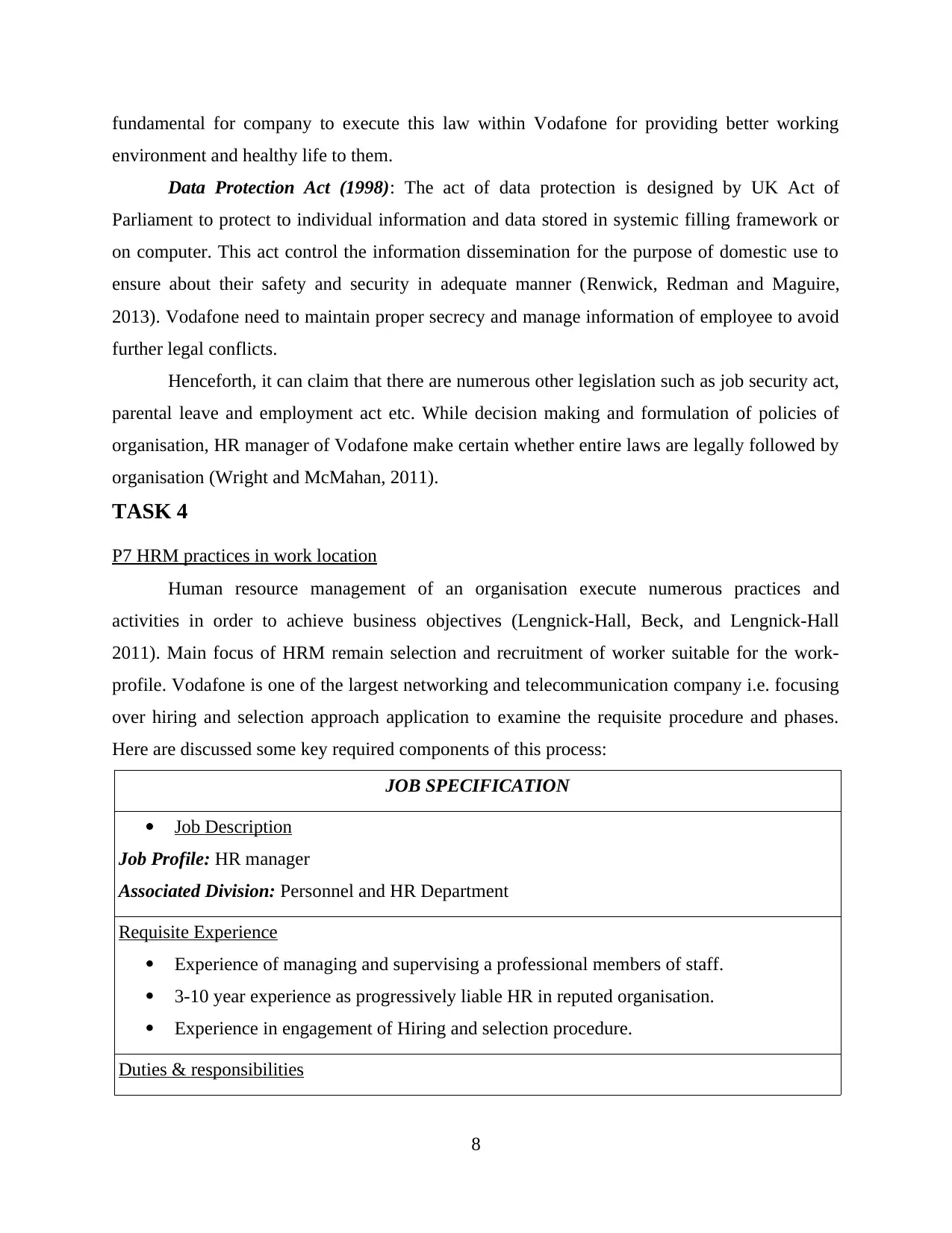
fundamental for company to execute this law within Vodafone for providing better working
environment and healthy life to them.
Data Protection Act (1998): The act of data protection is designed by UK Act of
Parliament to protect to individual information and data stored in systemic filling framework or
on computer. This act control the information dissemination for the purpose of domestic use to
ensure about their safety and security in adequate manner (Renwick, Redman and Maguire,
2013). Vodafone need to maintain proper secrecy and manage information of employee to avoid
further legal conflicts.
Henceforth, it can claim that there are numerous other legislation such as job security act,
parental leave and employment act etc. While decision making and formulation of policies of
organisation, HR manager of Vodafone make certain whether entire laws are legally followed by
organisation (Wright and McMahan, 2011).
TASK 4
P7 HRM practices in work location
Human resource management of an organisation execute numerous practices and
activities in order to achieve business objectives (Lengnick-Hall, Beck, and Lengnick-Hall
2011). Main focus of HRM remain selection and recruitment of worker suitable for the work-
profile. Vodafone is one of the largest networking and telecommunication company i.e. focusing
over hiring and selection approach application to examine the requisite procedure and phases.
Here are discussed some key required components of this process:
JOB SPECIFICATION
Job Description
Job Profile: HR manager
Associated Division: Personnel and HR Department
Requisite Experience
Experience of managing and supervising a professional members of staff.
3-10 year experience as progressively liable HR in reputed organisation.
Experience in engagement of Hiring and selection procedure.
Duties & responsibilities
8
environment and healthy life to them.
Data Protection Act (1998): The act of data protection is designed by UK Act of
Parliament to protect to individual information and data stored in systemic filling framework or
on computer. This act control the information dissemination for the purpose of domestic use to
ensure about their safety and security in adequate manner (Renwick, Redman and Maguire,
2013). Vodafone need to maintain proper secrecy and manage information of employee to avoid
further legal conflicts.
Henceforth, it can claim that there are numerous other legislation such as job security act,
parental leave and employment act etc. While decision making and formulation of policies of
organisation, HR manager of Vodafone make certain whether entire laws are legally followed by
organisation (Wright and McMahan, 2011).
TASK 4
P7 HRM practices in work location
Human resource management of an organisation execute numerous practices and
activities in order to achieve business objectives (Lengnick-Hall, Beck, and Lengnick-Hall
2011). Main focus of HRM remain selection and recruitment of worker suitable for the work-
profile. Vodafone is one of the largest networking and telecommunication company i.e. focusing
over hiring and selection approach application to examine the requisite procedure and phases.
Here are discussed some key required components of this process:
JOB SPECIFICATION
Job Description
Job Profile: HR manager
Associated Division: Personnel and HR Department
Requisite Experience
Experience of managing and supervising a professional members of staff.
3-10 year experience as progressively liable HR in reputed organisation.
Experience in engagement of Hiring and selection procedure.
Duties & responsibilities
8
Paraphrase This Document
Need a fresh take? Get an instant paraphrase of this document with our AI Paraphraser
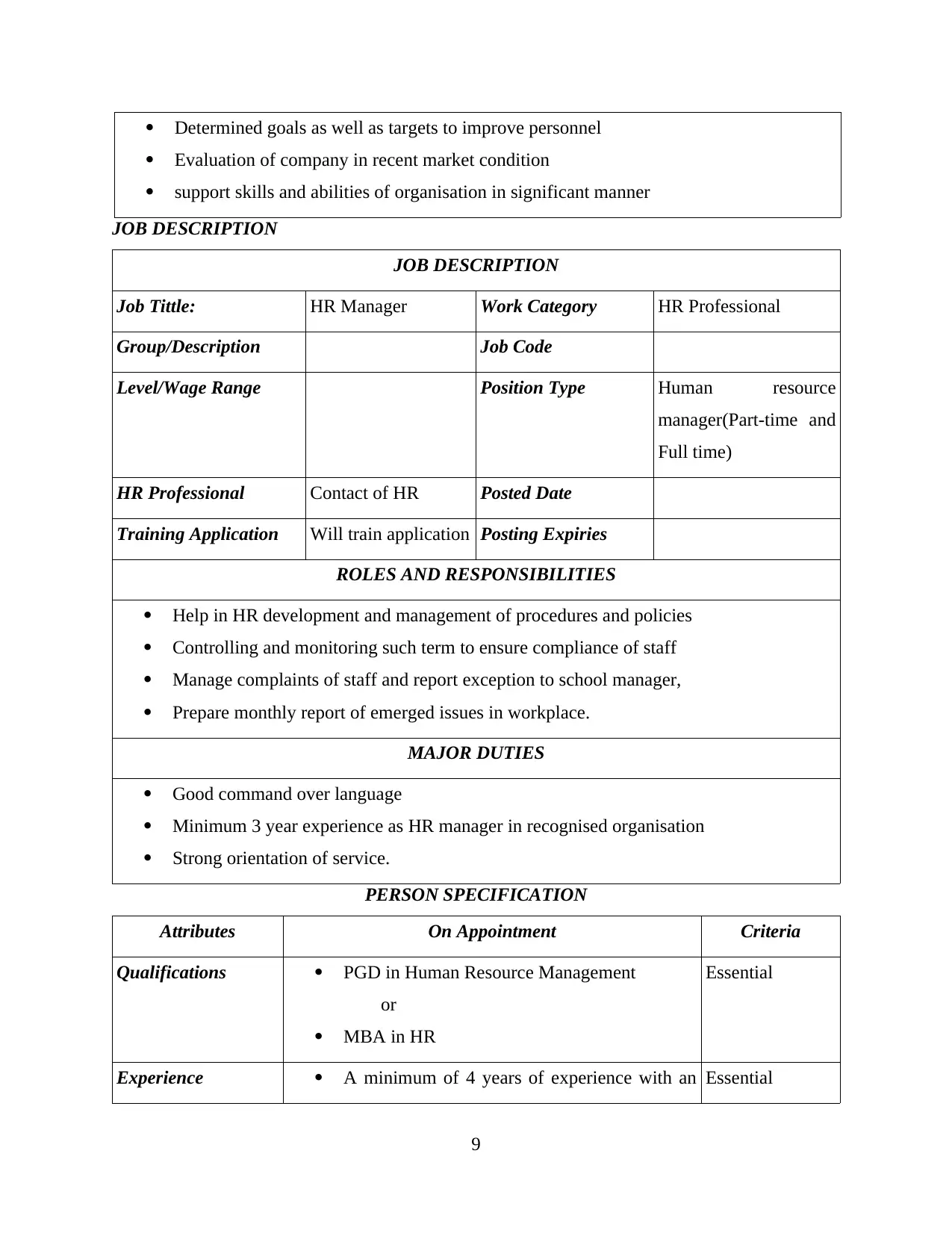
Determined goals as well as targets to improve personnel
Evaluation of company in recent market condition
support skills and abilities of organisation in significant manner
JOB DESCRIPTION
JOB DESCRIPTION
Job Tittle: HR Manager Work Category HR Professional
Group/Description Job Code
Level/Wage Range Position Type Human resource
manager(Part-time and
Full time)
HR Professional Contact of HR Posted Date
Training Application Will train application Posting Expiries
ROLES AND RESPONSIBILITIES
Help in HR development and management of procedures and policies
Controlling and monitoring such term to ensure compliance of staff
Manage complaints of staff and report exception to school manager,
Prepare monthly report of emerged issues in workplace.
MAJOR DUTIES
Good command over language
Minimum 3 year experience as HR manager in recognised organisation
Strong orientation of service.
PERSON SPECIFICATION
Attributes On Appointment Criteria
Qualifications PGD in Human Resource Management
or
MBA in HR
Essential
Experience A minimum of 4 years of experience with an Essential
9
Evaluation of company in recent market condition
support skills and abilities of organisation in significant manner
JOB DESCRIPTION
JOB DESCRIPTION
Job Tittle: HR Manager Work Category HR Professional
Group/Description Job Code
Level/Wage Range Position Type Human resource
manager(Part-time and
Full time)
HR Professional Contact of HR Posted Date
Training Application Will train application Posting Expiries
ROLES AND RESPONSIBILITIES
Help in HR development and management of procedures and policies
Controlling and monitoring such term to ensure compliance of staff
Manage complaints of staff and report exception to school manager,
Prepare monthly report of emerged issues in workplace.
MAJOR DUTIES
Good command over language
Minimum 3 year experience as HR manager in recognised organisation
Strong orientation of service.
PERSON SPECIFICATION
Attributes On Appointment Criteria
Qualifications PGD in Human Resource Management
or
MBA in HR
Essential
Experience A minimum of 4 years of experience with an Essential
9
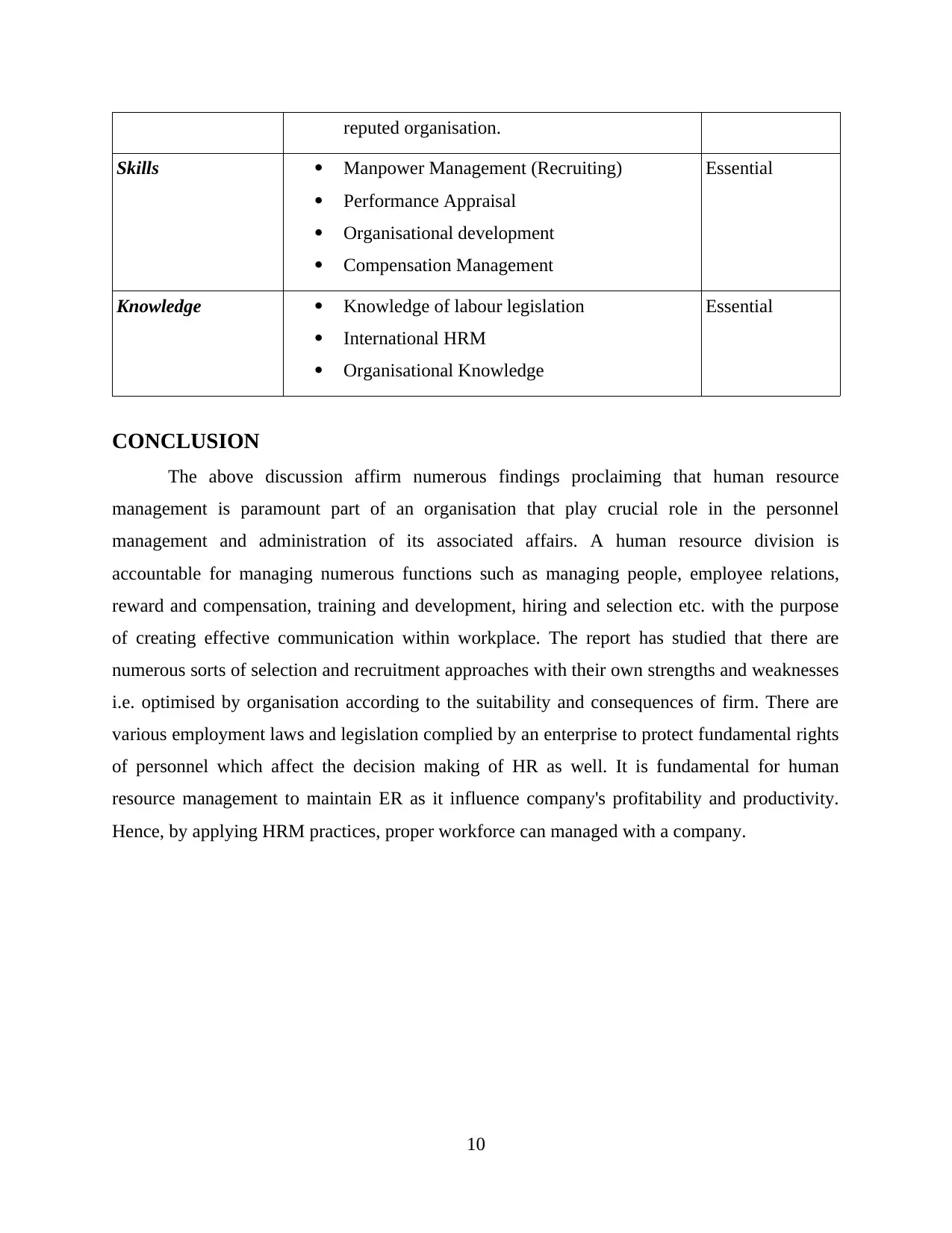
reputed organisation.
Skills Manpower Management (Recruiting)
Performance Appraisal
Organisational development
Compensation Management
Essential
Knowledge Knowledge of labour legislation
International HRM
Organisational Knowledge
Essential
CONCLUSION
The above discussion affirm numerous findings proclaiming that human resource
management is paramount part of an organisation that play crucial role in the personnel
management and administration of its associated affairs. A human resource division is
accountable for managing numerous functions such as managing people, employee relations,
reward and compensation, training and development, hiring and selection etc. with the purpose
of creating effective communication within workplace. The report has studied that there are
numerous sorts of selection and recruitment approaches with their own strengths and weaknesses
i.e. optimised by organisation according to the suitability and consequences of firm. There are
various employment laws and legislation complied by an enterprise to protect fundamental rights
of personnel which affect the decision making of HR as well. It is fundamental for human
resource management to maintain ER as it influence company's profitability and productivity.
Hence, by applying HRM practices, proper workforce can managed with a company.
10
Skills Manpower Management (Recruiting)
Performance Appraisal
Organisational development
Compensation Management
Essential
Knowledge Knowledge of labour legislation
International HRM
Organisational Knowledge
Essential
CONCLUSION
The above discussion affirm numerous findings proclaiming that human resource
management is paramount part of an organisation that play crucial role in the personnel
management and administration of its associated affairs. A human resource division is
accountable for managing numerous functions such as managing people, employee relations,
reward and compensation, training and development, hiring and selection etc. with the purpose
of creating effective communication within workplace. The report has studied that there are
numerous sorts of selection and recruitment approaches with their own strengths and weaknesses
i.e. optimised by organisation according to the suitability and consequences of firm. There are
various employment laws and legislation complied by an enterprise to protect fundamental rights
of personnel which affect the decision making of HR as well. It is fundamental for human
resource management to maintain ER as it influence company's profitability and productivity.
Hence, by applying HRM practices, proper workforce can managed with a company.
10
⊘ This is a preview!⊘
Do you want full access?
Subscribe today to unlock all pages.

Trusted by 1+ million students worldwide
1 out of 14
Related Documents
Your All-in-One AI-Powered Toolkit for Academic Success.
+13062052269
info@desklib.com
Available 24*7 on WhatsApp / Email
![[object Object]](/_next/static/media/star-bottom.7253800d.svg)
Unlock your academic potential
Copyright © 2020–2025 A2Z Services. All Rights Reserved. Developed and managed by ZUCOL.





